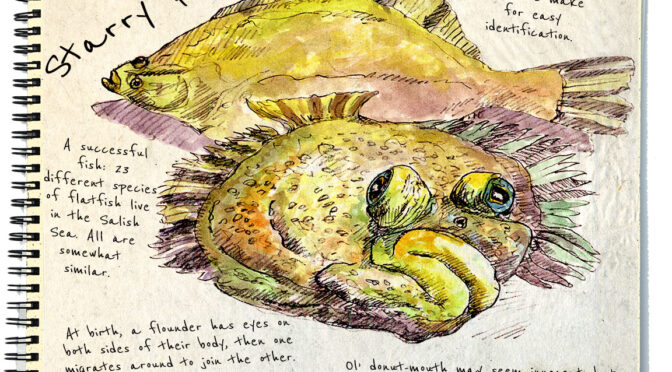A face only a mother could love. Starry flounders are just one species of 23 local ‘flatfish’. Flat because they tend to spend their time lying flat on the bottom, on either their right or left sides. Beginning life, they’re just a ‘normal’ fish that swim upright, an eye on each side of a vertical body. As they age, they spend more time laying sideways on the bottom, lying prone and just waiting for pry to swim close enough to grab. Soon, strange things happen with the growing juveniles, and it’s not just hormones. It’s a major anatomical change. One of their eyes actually migrates around their head to the other side, stopping just short of the other one. Now, the upside view has a pair of eyes looking for the next meal. These are hunters, after all, and they need binocular vision to assess distance. So, the flounder then has its same two eyes, but now they’re on the upper side of the body, like two little periscopes.
Starry flounders can grow to 36” long, or bigger than the size of a garbage can lid. At this size, they’re approaching 20 lbs and they can live upwards of 20 years. They’re often found near shore in bays or even fresh water and throughout the coastal North Pacific. They sport namesake star-like scales on both the lighter downside and darker upper side. The distinctive black bands on outer fins make it an easy flatfish to identify, and they can alter their colors to match surroundings. As predators, they often settle on a sandy bottom and wiggle their fins to cover themselves with sand and debris to hide. With only eyes showing as they move independently gazing about, and a mouth just waiting to go to work, they wait for a hapless crab or small fish to wander by, and then ‘wham’. Look for these fish as you bring your skiff through shallow water towards the beach. The fish’s outline is usually obvious from above.
Larry Eifert paints and writes about the Pacific Northwest from Port Townsend. His large-scale murals can be seen in many national parks across America, and at larryeifert.com.

